Executive Summary and Introduction
Benefit oriented value proposition, target customers, and first customers
The XYZ Education Agency will elevate value proposition since the business idea seems to be innovative and attractive to customers. In this context, the international students will be the ‘target customers’ and ‘first customers’; however, the UK institutes will also be a customer group, as they will offer commissions for the services delivered.
Business goals and objectives
- XYZ Education Agency intends to expand the business and establish new branch in China, India, Hong Kong and Bangladesh to provide services;
- It will increase budget for integrated marketing campaign to develop awareness program to protect international students from different fraudulent activities;
- It will enter into principal-agent partnership contract with 25 universities and increase net profit margin by 50% within next three years;
- It will provide proper information to the students, and identify cost effective sponsorship opportunities
Summary of market positioning, market and industry trends
XYZ Education Agency will position itself as a pioneering organization for higher education by targeting more than 570 thousand students who come for higher education; however, it is notable that most of those students come to the UK from China, India and other Asian countries.
Summary of business model
XYZ Education Agency will offer, transform, sustain, and deliver services using one portal and an exceptional software system; in addition, it will ensure right use of the policies, governance, assets, and resources.
Summary of value creation for all stakeholders
XYZ Education Agency will consider all stakeholders’ interest in the global market for higher education to build up international student’s future career; for instance, it will provide high quality solutions and offer cost effective services for the target customers.
Business Model
Academic Literature of Business Model
Zott, Amit and Massa (2011) conducted a landmark study on the concurrent development of the literature of business model and identified that various academic journals (around 1200 articles) have been published from 1995 to 2011. In these journals, the conceptual framework of business model has been presented in diverse forms with dissimilar approaches from the viewpoint of researchers in this area. Through a comprehensive study of business models academic literature, they found out that the theoreticians and scholars do not agree on a single definition of business model; they provided idiosyncratic perception to meet their study objectives without reconciling the other views that generated difficulties to develop harmonized progression with conceptual framework of business model. Although, there are numerous differences amongst the approaches of business models of different theoreticians, the emerging theme is that the business model represents the way a firm conducts its business; moreover, it enables the company to operate more systematically and develop the service quality and networks with partners to generate more value (Kuratko 2008).
Timmers (1998) stated that a business model is ‘an architecture’ of a firm’s information outflows regarding the players and partners of that business, its products and services that integrally generate revenues for the firm which stands on the composition and decomposition of the value chain interacting with the specified partners involved in that business action. Zott, Amit and Massa (2011) defined business model as an outline of business performance that connects customers and competes with the competitors through organisational resources and market factors in a longitudinal progression by using traditional theory of strategy; however, the modern e-business utilises information system and ERP implementation.
Osterwalder and Pigneur (2002) defined that a business model is ‘a conceptual tool’ organised with few elements that convey particular business logic of a commercial entity integrating the entire understanding of offering, customer selection and their utility maximisation, process of performance, configuration of resources and market, along with delivery system and revenue generation. However, Masanell and Ricart (2007) pointed out that business model is still a terminology rather than scientific modelling and it has aligned with the management thinking, but there is still no generally established clarity of business model to the academics and practitioners. Masanell and Ricart (2007) added that a business model would be constructed with two elements, such as:
- An array of choices: the first elements are organised with three types of sub-component and these are policies, assets, and governance;
- A group of consequences: On the other hand, the second elements are classified into two types as flexible outcomes and rigid outcomes.
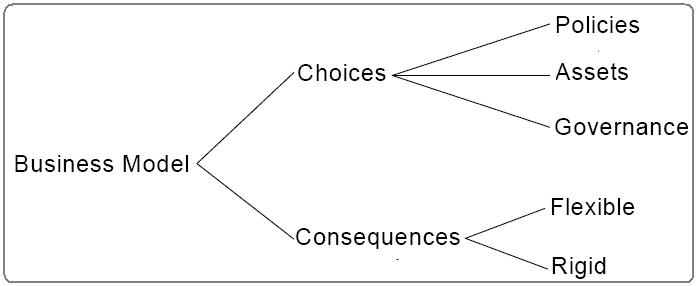
In the above model ‘Policies’ indicate the action plans that the business firms adopt for every portion of operation. For example, some firms oppose the employees’ union by setting the production plant at the area where labour cost is lower, providing higher monetary incentive to the employees but fly at economy class and so on. The flexible consequences are the outcomes that generate from the result of the sensitive choices; for instance, while a company increases its production volume, production cost falls and profit maximises; but rigid consequences are the ones that do not response promptly in relation to quick change of policies; in real life practice, there is no absolute flexible or fully rigid consequences.
Business Model for Education Agency
The present education agency will construct its business model with the policies to address all stakeholders’ interest in the global market for higher education to build up international students’ future career. The education consulting and admission agency service would be offered by a service delivery strategy and the strategic plan would be transformed, sustained, and delivered by integrating its ICT policy that jointly grounded an international marketing strategy.
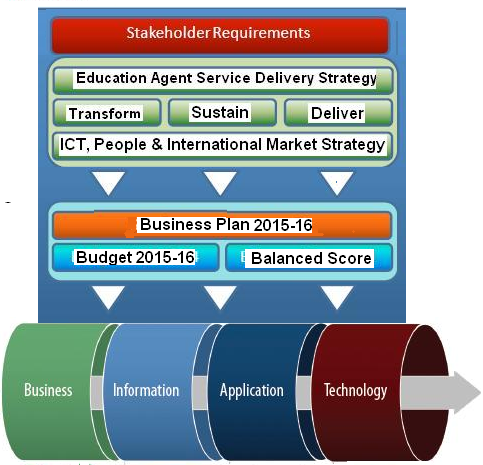
A detailed business plan would be organised by ensuring the right use of the policies, governance, assets and resources of the company while the governance system would be assessed and improved by using a balanced score card. As a result, the Business Model of Education Agency would represent the business with agency goals and strategies, provide information about service quality and necessary data; through such approach the prospective students would come for application of the service, and the ICT technology would be used to process the service and digital payment system for secured and easy transaction (Patchen 2014).
Industry analysis
Recent Trends and Future Projections for Industry of Education Agency
CMEC (2013) defined the term ‘education agent’ as a person or institute that gives information, advice and other related support to the students and their guardians in exchange for payment; however, such companies could act as immigration agents. Thomas (2011) stated that Education agents play a vital role in managing international students, though there are many controversial factors; however, students use such agents due to their knowledge and information gap and achieving their objectives without any barriers. On the other hand, Raimo, Humfrey and Huang (2014) conducted a research for British Council on education agents in this country and pointed out that British Council has taken many initiatives in order to develop this industry and ensure quality service for the international students, such as arranging different training programmes for the education agents and enhancing legal framework. HM Government (2013) reported that Universities of this country have a strong brand image about the international students, particularly Asian ones, since most of the students come from Asia to get quality higher education level; however, the following figure shows that in 2010, about 200 thousand students (50% of total) came from Asia, while 125 thousand students came from Europe. The next figure gives more information regarding the issue.
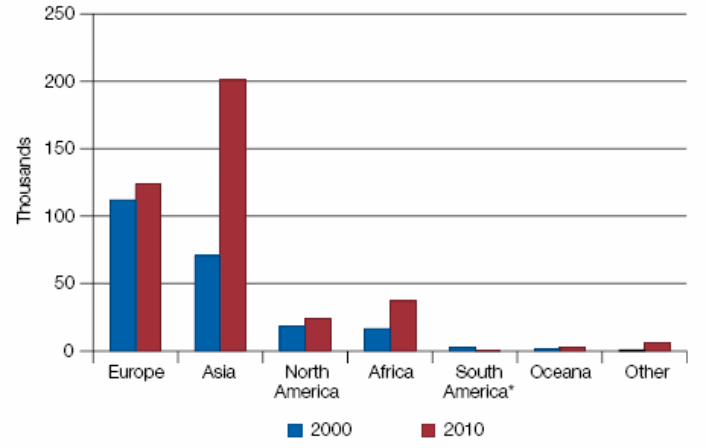
At the same time, HM Government (2013) reported that in 2010, about 350 thousand international students enrolled in the UK while in 2012, this number was more than 425 thousand; the subsequent figure gives more information in this aspect:

Raimo, Humfrey and Huang (2014) further stated that education exports value in 2011 was £17.50 billion to the UK economy and 500 thousand non-UK domiciled students studying in this country; however, 50 thousand (10% of the total) international students were recruited through agents and commission fee of £57.80 million. Raimo, Humfrey and Huang (2014) and HM Government (2013) reported that more than 40% of the total international students used or intended to use the services of education agents to arrange study abroad and find information about different education systems due to shortage of time and confidence.
ICEF (2015) noted that education agents have turned into unavoidable part of the UK educational institutes that helps to recruit foreign student. Recent study indicated that the UK Universities paid a commission of £86.7 million to the education agencies that are supplying forty percent of the total students in the UK Universities (British Council 2015; and DBIS 2013). Comparing the previous data of the education agency market indicated that the market volume is quickly expanding: 158 higher education institutions and especially the least renowned universities have tuned highly dependable on the education agents in order to recruit their student; consequently, the industry has a long-term prospect.
Porter five forces model and framework for industry analysis
Raimo, Humfrey and Huang (2014) reported that the importance of Education Agents is increasing day-by-day for students. This fact influences companies to enter this flourishing industry; therefore, competitive position of this industry has assessed considering Porter’s five-force analysis. However, subsequent figure gives brief description in this regard (Else 2014; Huang & Humfrey 2014; Morgan 2014; and Matthews 2012).

Threat of New Entrants
Sutherland (2015) stated that starting agency business in many countries is easy due to the lack of legal formalities to set up business while consulting business is still unregulated, though this scenario is different in the UK. However, new entrants need to consider financial risk as well. On the other hand, the new entrants enjoy many opportunities since the United Kingdom is a top destination country for international students: 48% East Asian and 41% African students contact them to get advice or relevant support; in this context, threat of new entrant is moderate in this industry.
Bargaining power of customer
The bargaining power of the customer is low in this industry because British Council reported that foreign students have knowledge gap along with problems related to culture and language; therefore, the agents have an opportunity to provide quality services to international students and to maximise profit margin.
Bargaining Power of Suppliers
The supplier’s power is very low in this industry;
Rivalry among competitors
There are many rival firms operating in this industry (Raimo 2013); so, the XYZ Education Agency needs to be cautious in formulating its pricing policy.
Threats of substitute
Nowadays potential international students try to reduce their expenses and collect information about their course and visa process using online service of the universities and colleges; in this context, threats of substitute product are high in this industry.
Conclusion on industry feasibility
McQuillan (2014) stated that university degree is not a commodity and it is a key to unlocking human potential; he further added that at present, higher education is treated as goods where agents effect successful overseas sales. However, complexity and ambiguities are involved in the principal-agent relationship. International students still depend on the UK Universities and their agents for higher education in spite of such controversy; market demand is too high as markets are large, active, hard and competitive; therefore, institutes use agents for strategic commitment to global student enrollment and for the distinguishing functions of agents (Raimo, Humfrey & Huang 2014). However, the following figure totals international students in the United Kingdom:
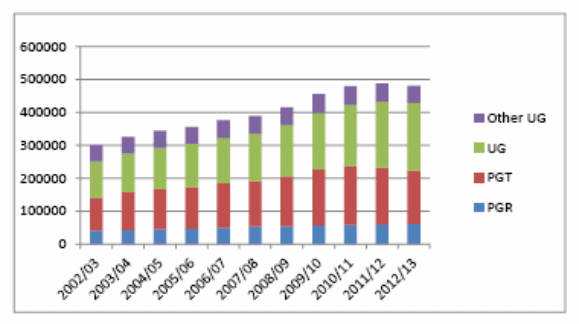
On the other hand, more than 36% of students come from China, 10% from India, 6% from Malaysia, and 6% from Hong Kong; this secondary data demonstrated that agents can handle Asian students more efficiently. In conclusion, it can be said that education agencies are highly important to institutes and international students as they serve both of them; they play vital role in diversity management and reduce information gap.
Discussion of Industry Risks
Raimo, Humfrey and Huang (2014) stated that strategic risk factors may cost more than total return because of an expensive marketing agenda; therefore, agents prove ineffective and expensive in order to boost the students’ registrations and applicant satisfaction; in addition, some agents involve in fraudulent practices and collect money from students. At the same time, education agents sometimes destroy reputation and brand image of the educational institutes by their fraudulent activities; in many cases, agents are liable for breach of trust while they are ignoring or not obeying the existing the UK Border Agency regulations; however, the next figure gives more information about industry risks:
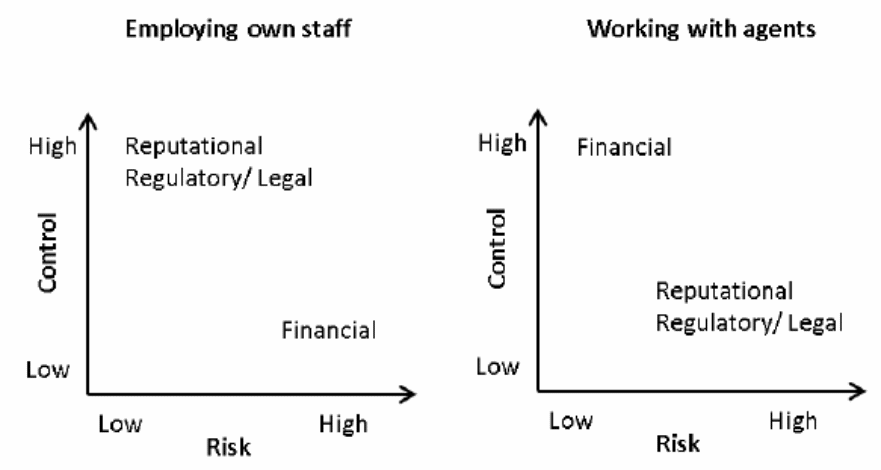
Market positioning and market analysis
Market positioning and strategy models
At present, more than 40% international students have taken services or planned to use the services of the education agents; however, Chinese and Indian students mainly contact the agents to obtain knowledge and information gap about the different education systems and to gain confidence to finish essential formalities without barrier in limited time-frame (Raimo, Humfrey & Huang 2014). At the same time, most of the universities in this country use agents and pay 10% of the first year’s tuition fee as commission for each student. Many international students try to solve their own problem by retrieving information from online database, but some students jointly involve with malpractice.
This problem can be reduced by taking different initiatives. In the industry analysis, it is clearly stated in primary and secondary data that most of the students came to the UK from Asian Countries. However, HM Government (2013) reported that 570 thousand international students had enrolled in the UK institutes for higher education in 2012 and 12500 students had taken facilities of distance learning. As target customers are the students of Asian Countries, they have knowledge gap and language problems along with financial crisis in some extent; therefore, this company must provide quality service and ensure integrity to develop brand image in the education market; considering entire market condition, this company will seek “more for more” to the international students. However, the following figure shows more details-

Market feasibility with conclusive survey
To better understand the feasibility of the selected target market, a primary market research has been conducted. It is important to state that the respondents of this field survey were ten international students who are studying at the UK institutes; moreover, the respondents were selected randomly from diverse backgrounds. The positive feedback of the survey provided the substantiation that the market positioning is reasonable.
Whether the students use or plan to use education agents?
Here 40% of the students said they use or plan to use education agents, whereas 50% said no and 10% gave no comments.
Whether the students get benefit from the advice of the education agents?
To answer this question, 40% of the students said yes , 20% said no, and 40% did not comment on this issue.
Whether the students think that they can manage without using agents?
Here 70% said yes, 20% said no, while the rest 10% gave no comments.
Whether the students think that the charges of the education agents are too high?
About 60% of the students think that the charges of the education agents are too high, while 20% disagreed to this and 20% provided no comments.
Whether the students think that, some agents give wrong information or commit fraud?
In giving feedback to this question, 20% said yes, 70% said no, and 10% selected the no comments option.
Whether the students think that they should rely on new company?
About 50% students agreed to this question, whist 30% disagreed and 20% remained silent.
Whether the students think that it is easier for global students to get agency services via online?
Here 80% felt it is easier for global students to get agency services via online, whereas 10% said no and 10% gave no comments.
Marketing strategy with implementation plan
Promotional Strategy
In most of the cases, registration process for services is complicated and time-consuming for the students; therefore, the management of this agency would endeavour to simplify the entire system to allow the foreign students to aware about this company through website. At the same time, the marketers of XYZ Education Agency would conduct an integrated marketing campaign in order to attract and educateinternational students (mainly Indian and Chinese students) about institutions in the UK, education system, other general information, sponsor, employment opportunity for the students and so on.
The aim of this campaign is to aware international students about fraud practice and to invest their money in perfect place. This campaign will help the international students to select right college or University and save their valuable time, efforts and money. Most importantly, the next table provides projected cost for social media advertising:
Table 1: Cost to conduct IMC Campaign for XYZ Education Agency. Source: Self generated
Implementation Plan
XYZ Education Agency will implement the above-mentioned proposed strategies by performing as a team; the chief executive officer will use democratic leadership approach and suggest members of this company to keep themselves updated about new regulations and education systems in the UK.
Training and Development
Many institutions have structured best practice guides or codes to develop agent-management practices by maintaining ethical standard; to represent the university accurately and influentially, XYZ Education Agency will train advisors, consultants and other members of human resource department.
Monitoring and Controlling Process
As the success of this business depends mainly on the reputation and quality service, management team of XYZ Education Agency will monitor and control the performance of the staff to provide services with trust and to become successful in this industry; monitoring and controlling process includes:
- Checking feedback of the Students and Institutions
- Direct communication process through email, phone and agent portal
- Take alternate action plan for minimizing problems
- Scope Verification and partnership with new institutions
- Performing Quality Assurance
Market Risks
- It is treated as less effective method to the universities due to more cost; therefore, they depend more on university staff; in this context, this new company should consider the issue before establishing business since University can terminate the agent contract;
- Sometimes agents commit fraud and misguide the international students, for instance, agents encourage underhand transactions and advocate investment of money in wrong place; therefore, international students face huge losses due to dishonest activities of the agents. However, the agency should work with integrity to develop brand image, otherwise it can’t sustain in the education market;
- Many education agents run business inefficiently due to lack of the monitoring, evaluating and training process;
- In many situations, education agents pass incorrect information to the international students because of complex financial system and regulation of the university; therefore, it becomes difficult for a new agent to work with full confidence by achieving their trust;
- At present, many international students directly contact with the university staff to minimize cost and get appropriate information as well, which may reduce market demand of the agents;
- Here, it is important to point out that higher education can be considered a commodity or a consumer product for which the provisions of the laws have designed with integrity for higher education places, for example, Bribery Act (Raimo, Humfrey & Huang 2014; and Raimo 2013);
- On the other hand, education agents are liable for breach of trust, as they are not following the present regulations of the UK Border Agency; moreover, frequent change or amendment of the codes and regulations create serious problem of the agents to carry on business due to information gap. As a consequence, UKBA visa refusal rates have increased and international students’ education life seriously hampered for ill-informed or dishonest agents
- Other market risks include presence of competitors in this industry, global financial crisis, reduction of purchasing power of the customers, complex visa and application processes, unscrupulous agents, language barrier and geographic distance, ability to attract international students for the trial subscription and so on.
Financial plan and risk analysis
Start-up budget
Two investors will invest equally to establish XYZ Education Agency and investors will provide £74625 each accordingly and the rest of the fund will be generated from Bank loan; aggregate fund will be sufficient to start business and meet up cost of first year business operation. Most importantly, start-up cost is comparatively high for this business since it needs to expense large amount for advertising and contracting with different institutes in the UK. The following figure gives projected start-up budget for this Agency:
Table 2: Start-up budget. Source: Self generated
Projected Cash Flow for three years
Estimated net cash flow from operating activities would be £214756, £1423420, and £3709429 in the next three years; subtotal cash spent will increase by £2472789 from 2016 to 2018 while subtotal cash from operations will enlarge by £2758521 in this period; however, the next table provides more prediction in this regard:
Table 3: Pro Forma Cash Flow of XYZ Education Agency. Source: Self generated
Balance sheet for three years
Total assets will increase by £5263479 from 2016 to 2018, total liabilities will grow by £73530 in this period; at the same time, earnings and total capital of XYZ Education Agency will increase over time; the next table provides more prediction about total assets and liabilities:
Table 4: Pro Forma Balance Sheet of XYZ Education Agency. Source: Self generated
Sales Forecast
It will earn £138280 per month in the first year:
Table 5: Sales Forecast. Source: Self generated
Funding sources and revenue streams
In the start-up budget segment, it has already been discussed that two entrepreneurs will invest equally and rest part will be provided by the bank; however, net profit margin will be approximately 12.54%, 42.41%, and 56.24% in the next three years. XYZ Education Agency will generate revenue from two sectors, for instance, it will earn from students by giving advice, preparing documents for enrolment and visa process, and so on; at the same time, it will seek at least 10% commission from the institutes for enrolment of each student through this company.
Cost structure and approach to costing
Table 6: Pro Forma Profit and Loss Statement for XYZ Education Agency
Assessment of all important risks, their likelihood, potential impact
XYZ Education Agency is not the first agent in the UK, which would like to ensure quality services; however, many competitors have British Council trained agent status and these agents operate by following formal legal framework and Code of Ethics. At the same time, it would not be possible for XYZ Education Agency to offer extensive services in the global market due to deficiency of start-up funds while competitors have branch in the prospective countries along with online services. Furthermore, it has not enough experience to operate in this industry and control costs, for example, entrepreneurs have no initial knowledge about the costs of principal-agent partnership, database management system, legal framework, enrolment procedure for students of different countries and so on.
Ways to minimise risks, and reduce their likelihood
XYZ Education Agency should concentrate more on the IMC Campaign and multimedia marketing strategy in order to warn the international students about collecting proper information to save them from fraud agents; therefore, students will be able to use perfect agents for their higher education. At the same time, the management team of XYZ Education Agency should concentrate more on the monitoring and training programme to provide correct information to the international students while the UK Border Agency changes regulation frequently.
Overall conclusion on the risks and their possible uniqueness
Strategic, legal, and financial risks are the main concern of this education agent. It will focus more on the training program to mitigate this risk and develop a unique communication system to give instant feedback to the students; in addition, it will work with integrity and maintain ethical standard.
Pricing Strategy
XYZ Education Agency will offer very low price for its services while it will get commission from the institutes. It will provide some essential information at free of charge and when students get more information for free, they will be interested in logging on this site for additional paid services. Here, it is important to mention that this agency will charge international students a competitive price for preparing their documents; they will get discounts for using multiple services of this agency.
Financial feasibility and break-even
From the projected balance sheet, cash flow statement, and income statement, it can be said that this business will be feasible for the entrepreneurs; in addition, return on equity will be 59.61%, 80.76% and 67.29% respectively. XYZ Education Agency will reach break-even point after ninth month of starting business; however, it will also depend on the number of international students who use its service. The following figure shows in detail:

Operational Plan
The operational plan for the XYZ Education Agency Company has been laid down below to comprehend the functioning of the business better and to illustrate the means by which the business should proceed with its operations from the initial years and continue it successfully in a long run.
Legal Structure for the Business Activity
The two entrepreneurs will start the XYZ Education Agency Company as partners; as a result, it would be a partnership business established by compliance with the Partnership Act (1890). This means that the company would not have a legal personality of its own, and the partners themselves would be accountable for the liabilities or losses incurred by XYZ Education Agency. Both the entrepreneurs would be general partners and would be completely responsible for company’s debts, and the functioning of the company would be administered through a Partnership Agreement, the conditions of which would be decided by the entrepreneurs. Ddditionally, both the entrepreneurs would share the profit equally which would be left after paying liabilities, wages, rents, taxes, and other costs.
Compliance with Necessary Laws, Regulation, and Licenses
The XYZ Education Agency with have its head office in the United Kingdom and it would operate under the English legal system; as a result, it would comply with all the laws and regulations of the United Kingdom. It would start as a partnership business; so, it would accordingly conform to the laws on company formation, taxation, torts, contracts, as well as labour laws, environmental laws, European Union regulations and treaties, such as assurance of free movement of services and person, and equal treatment of workers from the EU member states, and giving due regards to job-seekers. XYZ Education Agency would have affiliations with the British Council and the British Council would give it appropriate licenses to enable it to operate legally in the global platform by assisting it to reach the foreign students who would study in the UK. XYZ Education Agency will commence the business with compliance with the Partnership Act 1890, but it would also endow its highest efforts to make sure that the operations can be carried out without any complexity between the UK domestic laws and the EU legal framework.
Organisational Structure and Staffing
The entrepreneurs of the XYZ Education Agency are determined to create a very simple and plain organisational structure and staffing because it will not be feasible to employ a large number of workers, managers, consultants, and advisors in the first three years of operation. In addition, keeping a lucid, understandable, and straightforward organisational structure would make it easier to effortlessly and efficiently control and administer the business in the longer period as well.
For better understanding of the organisational structure and staffing of the XYZ Education Agency, the configuration has been briefly illustrated in the figure below; moreover, it is notable that the company managers would be at the top level; in fact, there would be Chief Executive Officer, Chief Financial Officer, and Executive Officer for Operations. Right below their rank, there would be two advisors, namely, the Senior Policy Advisor and the Educational Advisor. After that, there would be four institutional consultants, four foreign student consultants, five student coordinators, and one Senior Analyst for multiple purposes.
There would be permanent in-house IT experts and web developers working as employees at XYZ Education Agency, because this business will heavily rely on technology and it will need to maintain company website and other IT infrastructural amenities constantly. There would also be a local technology consultant company working with XYZ Education Agency irrespective of having in-house IT specialists. Such business requires high-level of cyber security and so it is important to make sure that the business has adequate back up systems to reconstruct the IT facilities swiftly and effectively subsequent to an unwanted hacking or cyber malfunction. In addition, there would be some subordinate temporary workers, such as office boys and other staff, for example guards, electricians, and receptionists.
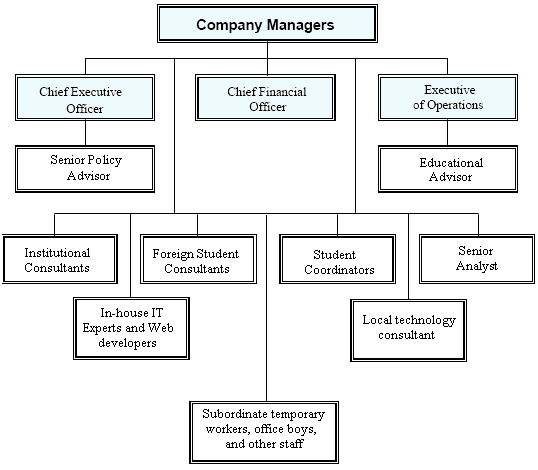
Technology used in the business
This business will be heavily reliant on the use of technology in order operate in the initial years; in first three to five years, it will not be possible to create physical offices in different parts of the world. Moreover, even if physical offices are constructed after three to five years, technology will still remain the best tool to help the agency run successfully. This is because technology will allow to perform fairly harder tasks quickly and efficiently at low costs, saving substantial time, money, and labour.
Creating a customized dynamic website would be the foremost task. In addition, the business needs to have numerous computers (which the employees would use to communicate with the students and assist them), a local technology consultant for full 24/7 support, data security back-up for protection from cyber crimes like hacking, email generation, social media and online marketing. In first three years, web-authoring software (such as Dreamweaver and MS front-page) will be required to generate web-content, as well as some other software, such as word-processors, desktop-publishing software, multimedia, site manager for configuring site and revising links, web-administration software, and so on; however, intranet protocol would be highly essential to share information between employees and managers. On the other hand, a database platform would be highly important in order to systematize the information of the various students and the UK institutes, which would allow the data to be abridged and secured, thereby replacing the possible use of large manual files; moreover, proper synchronisation between the protocols, IP-addresses, and ports, and registering several domain-names would be crucial.
Most importantly, the XYZ Education Agency must look forward to consulting with the in-house IT experts to integrate cloud-computing facility within the company because cloud-computing would allow the employees to maintain the communication and database networks better in order to serve the students and institutes better. In this instance, use of hybrid cloud-computing system would be the most suitable approach since maintenance of such a huge global network will require the most efficient functioning system.
Mode of Operations
It is important to state that the business will mainly be operated online in order to reach diverse students from a range of different countries in an easy, effortless, efficient, and cost effective way. It will not be feasible to operate through physical offices in so many Asian and African countries at least in the first five years after the start up. This is because the business will start its operation with limited funds and investing so much in building permanent premises all across the globe would be entirely impossible. This does not mean that this agency will not offer its services in countries like Pakistan, Sri Lanka, China, India, Bangladesh, Malaysia, Australia, and African countries; in fact, this agency will help students from all those countries to come and study in the UK in a trouble free environment by the use of internet.
However, it will definitely have a permanent office, or more specifically, ‘the headquarters’ in the UK at the initial stage. As a result, it is better to say that the mode of operations for this agency’s business would be a combination of permanent and online media, even though the business will highly rely on the internet. For this purpose, the entrepreneurs look forward to creating a smart and dynamic tailored website, using which advice and other specific assistance will be offered to the students. The website would be user-friendly and easy to navigate so that it is easy for students to book the services offered. In addition, social media, online marketing and other promotional tools would be applied so that an increasing number of students find out about the facilities offered and the mode of operations becomes successful.
Business Location
The business will be operated all over the world via internet for the convenience of foreign students trying to study in the United Kingdom; however, the headquarters of this business will be located in the United Kingdom. It is highly important to note that in the initial stage of the business, particularly, in the first year of its operations, it will not be quite possible for the business to open its representative offices in various parts of the world. For this reason, in those countries where there are many current and potential students who could join the education industry of the UK, the business would operate via internet in the first years. However, in the later years, when it becomes possible for the business to accumulate substantial funds and recover from its loans, it will be viable and pragmatic for the business to start physical operations in those countries by running tangible administrative centres. The entrepreneurs look forward to building administrative centres in countries such as China, India, Bangladesh, Pakistan, Sri Lanka, Malaysia, Australia, and African countries. In the second year, opening up offices merely in China and India would be the target.
Nevertheless, it is essential to focus on the fact that in the first year of its operations, the United Kingdom will be the first priority to build an office because the business will be ‘headquartered’ in the UK. It is very imperative for the business to choose such a location within the UK from where it will be easy to get in touch with the foreign students living in the UK. This will make it easier for the distressed foreign students to instantly seek help whenever necessary without the need to travel a long distance to contact this agency. At first, the choice was to select a location within London where there are many universities and colleges; however, later on it appeared that it might be necessary for those students to look for assistance at any time, and not merely during their learning hours. With highest emphasis on this fact, it has been decided that the location of the business will be in an easy to access place for a huge number of Chinese, Bangladeshi, and Indian students who came to the UK for educational purposes and need serious assistance.
It is interesting that the Chinese community in London mainly lives in the Chinatown of London (where there are many target customers) while the Bangladeshi and Indian communities are mainly occupying the East End of London since 1950s (migration by the South Asians is still continuing today for diverse educational purposes). An even more interesting fact is that the Chinatown is situated in a proximate area of the East End of London, which means locating the business in this area would mean that the agency could effortlessly access Asians coming in the UK for higher studies. It would be highly feasible for the business to rent an office space instead of buying a space in order to keep the costs lower in the first year; it is notable that there are many agencies and commercial spaces for rent in the East London, and large luxurious offices are available in the Liverpool Street at comparatively lower rates. As a result, Liverpool Street of East London is the chosen location for operating the headquarters of this business in the UK in initial years of operation.
The Key Business Processes
The key business processes of the company has aimed to reach the international education market through ICT enabled services and customised software that would assist the company to draw attention of the millions of students eager to achieve foreign degree. The company would create online portal where the enthusiastic students would get all relevant information about the desired institution, and create own account to place an application for admission process and even making payment for admission and tuition fees. The company would continue online campaign, social media marketing and maintain the regular search engine optimisation activities that would bring the potential students to the order page of the XYZ Education Agency at its online portal that would attract worldwide students’ mobility.
Discussion of decisions made with rationale and evidence
In the following portion of this paper, I have presented methodically and reflectively some discussions of the decisions, which I have made in due course of carrying out this business plan with apt rationales and evidence.
Start-up Development
Business Idea Selection
I was prompted to work on this business idea because there is evidence that throughout decades the young students from diverse parts of the world undergo serious problems and uncertainty in the UK when they seek to pursue their education there.
Decision that this is a Feasible Business Opportunity
It appeared to me that this decision is a feasible business opportunity because large numbers of students from China, India, Bangladesh, Pakistan, Sri Lanka, Malaysia, Australia, and African countries pursue or attempt to pursue higher education in the UK in order to become more competitive in this era of globalisation. However, this path to become more competent is not free from obstacles and many students suffer from serious problems due to deficiency of advice or consultancy; so, the decision was to help them study better, work and live in the UK in return for some fees.
Reasons for Selecting the Services and Final Value Proposition
After carrying out the primary market research, using the questionnaire I have prepared (which had been included in the appendix as evidence), it became clear to me that the services I am planning to offer have a huge demand among the students and the institutes as well. The feedback of the respondents provided adequate evidence and justification that this business will have high value proposition because my business idea was original and appealing to clients.
Choice of Mode of Operations
I believe that a combination of presence in both online and permanent premises is essential for this business because operating merely by internet will not help assist the student in reality, whereas operating merely through permanent establishment will not allow offering the services efficiently to students around the globe.
Choice of Funding Sources and Revenue Streams
I would start the business as partnership with my friend, and I decided that the funds should be contributed by both of us and the bank; although there are only two investors, I believe I would be able to use money effectively; however, revenues would be generated when students pay for services and institutes give us commissions.
Choice of Location for Business Premises
I was interested in finding a location from where it would be possible for my business to find a huge number of migrant students in the UK – and I believe that I have successfully identified the apt location in my plan.
Marketing Channels
I have placed greater stress on online marketing via social media, online-integrated marketing campaigns, and other online promotional codes; moreover, the key marketing channel for the XYZ Education Agency Company would be the official website, through which it would market its services to the target customers. This seemed to be the most viable method to me due to limited funds; this channel would allow an effective and pleasant marketing.
Target Customers and First Customers
I have decided that this business would have two types of target customers; I believe the international students would be the first group or early adopters of the services I would offer because these people are mostly in need for assistance. However, I felt that the other type of customers would be the institutes with whom we would have affiliations, as they offer us some commissions for directing students in their universities or colleges.
Discussion of four decisions with evidence of information used
The Decision on Choice of Mode of Operation
I strongly felt that it would not be possible for XYZ Education Agency Company to operate globally without relying on internet as the key mode of operations. However, I felt it was necessary to assess this; therefore, I have tried to gather evidence that the key customers, namely, the international students, would find it easier to get agency services online. To check this out I have used the results, namely, the evidence that I got from the primary market research that has been conducted (see questionnaire in appendix). It is notable that most of the respondents believed that the online mode of operation would be the most viable method to conduct an agency business, as shown by results of Question 8; this prompted me to settle on the chosen mode of operation affirmatively.
The Decision on Choice of Premises
It is a common knowledge in my field of research that the location chosen for conducting the business must be proximate to the customer; I have studied Business and Economics for a substantial time in my life, and learned many things from my University. Using this knowledge, I decided that Liverpool Street of East London would be the most suitable premises for conducting the business because the first customers, namely, migrant students from China, Bangladesh, and India live very close to this location. In addition, I also discovered that the office rent in that particular area is quite lower than in other ones; to gather information, I have visited some non-academic sources. For example, I read advertisements on commercial space rents in newspapers, and also visited the Gumtree website to check the advertisements posted by different people about rent available.
The Decision on the First Customers
The first customers of my business are the central point of attraction because the entire business has been designed surrounding them. In order to collect evidence of the information that making the international students the first customers would be highly beneficial for the XYZ Education Agency Company, I have prepared two specific questions on my primary market research questionnaire. To be frank, these were Questions 2 and 7, and the results of these questions have provided me with sufficient substantiation that making international students the first customers would help the business to flourish.
The Decision on Business Idea Selection
I have observed throughout the past decade how much difficulty an international student undergoes while coming to study in the UK. The troubles they face are multifaceted, and they always require advice, updated information, moral support, and other assistance while participating in the edification process in the UK institute. I always wanted to help such students with consultancy and other benefits, which have paved the way for this business plan. However, I must say that my business idea was completely crude when I started to work on it; nevertheless, I started to collect some evidence that could help me to formulate a refined and perfect business idea. I found a file named “Managing International Student Recruitment Agents Approaches, Benefits, and Challenges”, written by Raimo, Humfrey, and Huang (2014); I have studied this file thoroughly and used the information that was available there to make the final decision about the chosen business idea. I feel that I have been very critical about the choice and formulation of the business idea; however, at the end the final business idea was quite inspiring.
Four events on experiences in entrepreneurial activities
I would say that the four events, during which I gathered the experiences to develop my entrepreneurial traits and intentions to carry out the commercial activities were when I decided on the mode of operation, chose the premises, made the decision on the first customers, and selected the business idea. I was required to think like an entrepreneur in deciding the issues realistically by focusing on my business risks, weaknesses, and strengths.
Eight reflective chronicles
I have used my entrepreneurial skills and faculties to choose the funding sources and revenue streams, location for business premises, marketing channels, target customers and first customers, business idea, mode of operations, feasibility of business opportunity, and the services and value proposition; this has been broadly analysed in the reflection part.
Conclusions about personal career, entrepreneurial traits, skills
In carrying out this project, I have gathered incredible skills on personal career and entrepreneurial traits; I have performed impressively in the employability challenge event and in the “out-of-class” group event and I am satisfied by the method in which I have revealed my employability and other skills in both the instances. I must say that my entrepreneurial traits and abilities were further developed by the events during which I have planned the entire business; to be specific, in events of identifying the risks of my business and analysing the way they could be sorted out to ensure the regular flow of revenues, my skills were further enhanced.
Conclusion: Skills and leadership abilities
I strongly feel that my skills and leadership abilities have been enhanced by the knowledge I gathered from those events; due to the assistance from my gurus I have achieved many leadership abilities. I must admit that these leadership abilities include a diverse range of capabilities, such as working with complete willpower, making brave attempts to undertake risks, having greater self-confidence, desire for learning, comprehending stoppages, being obsessive about business, adaptively organizing funds, building professional networking, and so on.
Reference List
British Council 2015, Education agents, Web.
CMEC 2013, The Role of Education Agents in Canada’s Education Systems, Web.
DBIS 2013, International education: Global growth and prosperity, Web.
Else, H 2014, Non-EU students attending UK universities, Web.
HM Government 2013, International Education – Global Growth and Prosperity: An Accompanying Analytical Narrative, Web.
Huang, I & Humfrey, C 2014, Power and Control: Managing agents for international student recruitment in higher education, Web.
ICEF 2015, Education agents continue to play a larger role in UK recruitment, Web.
Kuratko, D 2008, Entrepreneurship: Theory, Process, and Practice, South-Western College Pub.
Masanell, R & Ricart, J 2007, Competiting Through Business Model, Web.
Matthews, D 2012, Grand fee paid for each foreign student, Web.
McQuillan, M 2014, Cool it, Which? A degree is not a fridge, Web.
Morgan, J 2014, Licences to recruit overseas students at risk, Web.
Osterwalder, A & Pigneur, Y 2002, Business Models and their Elements, Web.
Patchen, I 2014, How to Start a Educational Consulting Business, MicJames Official Publisher.
Raimo, V 2013, Agents – The business case for an ethical approach, Web.
Raimo, V, Humfrey, C & Huang, I 2014, Managing International Student Recruitment Agents Approaches, Benefits and Challenges, Web.
Sutherland, S 2015, Starting your Own Education Agency, Web.
Thomas, D 2011, Education agents are vital: British Council, Web.
Timmers, P 1998, Business Models for Electronic Markets, Web.
Zott, C, Amit, R & Massa, L 2011, The Business Model: Recent Developments and Future Research, Web.